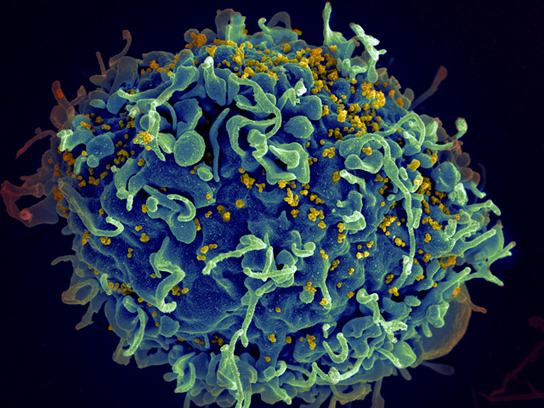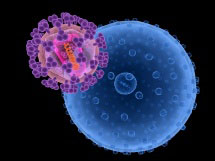
Researchers at Johns Hopkins Bloomberg School of Public Health are studying the complex interactions between HIV proteins and human proteins. By focusing on the interaction between Vif and APOBEC3G, they recently discovered a new protein, CBF-ß, that enables HIV to destroy human cells. The researchers plan to conduct further tests with CBF-ß and Vif in the hope of eventually being able to prevent the degradation of APOBEC3G.
A team of researchers at the Johns Hopkins Bloomberg School of Public Health recently discovered a new protein that enables HIV to destroy human cells. The finding provides scientists with a critical glimpse into the complex interactions between HIV proteins and human proteins, a discovery that could potentially lead to new HIV drug therapies. The study was published in the January 19, 2012 issue of Nature.

HIV is a small but efficient pathogen that includes about 15 proteins that can act in various combinations with the more than 30,000 proteins in the human cell. APOBEC3G is a human protein that has the power to mutate HIV’s genome and prevent infection. However, an HIV protein called HIV-1 viral infectivity factor (Vif) typically associates itself with and degrades APOBEC3G before it can do its job.
Focusing on the interaction between Vif and APOBEC3G, researchers found that another protein called CBF-ß was a key factor needed in order for the degradation of APOBEC3G to take place.
“I’ve been working in this field for over 25 years and I am certain that there is still even more left to this story,” explained Xiao-Fang Yu, MD, DSc, professor in the Bloomberg School’s W. Harry Feinstone Department of Molecular Microbiology and Immunology and lead author of the study. “This is an exciting time to be in HIV research.”
“The identification of CBF-ß is only one piece of the puzzle, but it’s an important one,” said Sean L. Evans, a PhD candidate in the Department of Molecular Microbiology and Immunology and one author of the study. “The human protein APOBEC3G is designed to weaken HIV, and the virus has evolved a mechanism for defeating this anti-viral factor.”
There are currently more than 20 approved HIV antiviral therapies, some of which target protein interactions between the virus and humans. However, drug failure and the emergence of drug-resistant variants make it necessary to further this research and continually expand the number of HIV drugs available.
The next step, now that scientists have identified CBF-ß, will be to test various inhibitors and potential drug therapies to determine which ones disrupt the interaction between CBF-ß and Vif, and, therefore, which ones can prevent the degradation of APOBEC3G.
“Understanding these interactions is essential to the intelligent design of drugs that can fight HIV,” continued Evans. “If we can stop Vif from degrading APOBEC3G, HIV would be severely crippled.”